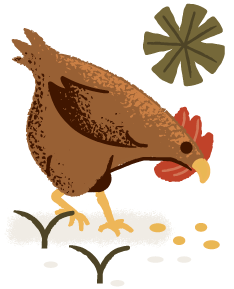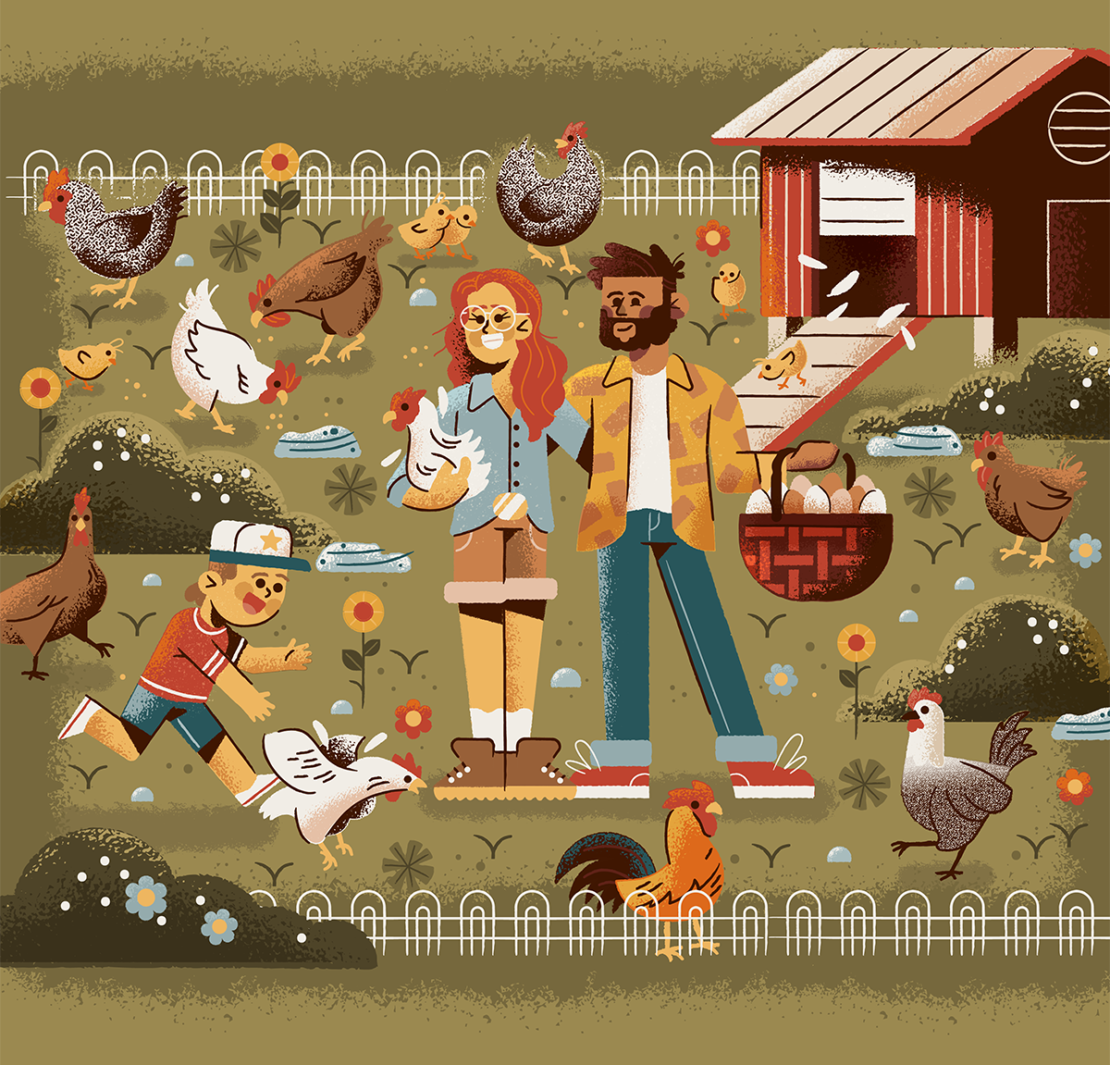When registered nurse Dawn Gray steps away from taking care of people, she steps into her 4-acre Kentucky backyard, cheerfully singing “You Are My Sunshine” to her beloved 25 chickens. The 48-year-old says she keeps chickens for entertainment and, of course, the eggs. “I just wanted to get fresh eggs and get as much fresh food as possible off our property,” she says.
But the eggs serve as just an edible perk. It’s the chickens themselves that deliver the joy. Gray describes one of her chickens as “unique looking” thanks to an amber-colored mask encircling its beak and eyes, so she named it Sunshine, which serves as the inspiration for the daily chirping of the Johnny Cash’s classic. Whenever she wants to pick any of her chickens up or get them huddled into their coop for the night, she simply tunes up her voice and begins singing the Cash classic. The chickens listen and then follow her vocal lead.

“They’re very personable,” Gray says. “A lot of people think chickens are dumb, and they’re not. They’re actually pretty smart.” The Kentucky resident began her fowl love affair with just six, but she soon fell for their temperament, low maintenance, low cost, and rewards. “My husband actually thinks I have an addiction,” she confesses. However, two years ago when the couple decided to start downsizing their livestock, she and her husband said goodbye to their pigs, ducks, and rabbits — but all of their chickens remained.
Gray and her husband share their chicken commitment with a growing number of people. “Within the past five years, it’s becoming more popular for more populated areas to have a small amount of chickens in their backyard,” says Rachel Moody, a dairy, equine, and livestock educator from Cornell Cooperative Extension. “They are becoming more prevalent in homes.” Based on the most recent 2013 U.S. Department of Agriculture report on chicken ownership in urban areas, millions of Americans across four major cities — Denver, Los Angeles, Miami, and New York City — raise chickens in their backyard. And the reasons for chickens’ popularity are reflected in the attributes cited by Gray and echoed by poultry professionals — little maintenance, appealing dispositions, low cost, and big rewards. They also serve as the emblem of the farm-to-table movement and provide easy access to locally sourced food, which is why many refer to chickens as “the gateway farm animal.” Whether it’s an ingredient for a birthday cake, a breakfast option, or an item in a casserole, chickens make locally sourced food easy for their owners. “People like the idea of controlling their food source and knowing where their food comes from,” says Moody. “That’s the payoff.”
My husband actually thinks I have an addiction.
And it’s a pay off with a very low maintenance bar. “As long as they’ve got food and water and have an appropriate amount of space, they don’t need anything. They are self-sufficient to a point,” says Tom Watkins, vice president of quality poultry provider Murray McMurray Hatchery in Iowa. While a cow may need 10 acres of free range, a chicken only needs about 10 square feet to live its best life, and even three square feet of indoor space will suffice, Watkins says. For backyard operations, the main challenge is the pursuit of a free-range existence. “They’ll go into your neighbors’ yards, and the number one killer of chickens are neighborhood dogs and cats,” says Jeannette Beranger, senior program manager at Livestock Conservancy, a nonprofit organization aimed at protecting livestock and poultry.
In fact, Watkins says his 6-year-old daughter could raise one by herself with some adult supervision, noting that chickens, are more often than not adaptive to humans, and require no more work than a cat, if not less. For that reason, they provide a nice entree for children to learn about taking care of pets, as they instill great responsibility in children. “They’re easier to take care of than dogs and cats,” Beranter adds. “Chickens are a piece of cake.”

Chickens’ ability to adapt to humans may explain why sometimes owners, such as Gray and several of her friends, begin pampering their chickens, letting them indoors and even placing the animals in diapers occasionally (if you can imagine). While the Kentucky farmer would very much rather raise her livestock outdoors, sometimes her livestock prefers otherwise. “The six chickens that I had, once I moved them outside, they got depressed,” Gray says. “But as soon as I put the baby chicks in with the rabbit, they started doing the Irish jig and started hopping and were all happy.” Chickens seem to get along well with most animals — male ducks being the exception. According to Gray, it’s unwise to keep drakes (male ducks) near hens, as their aggression can become dangerous. “You cannot really have them around females because they will try to mate them,” Gray says. “They can actually kill a hen trying to mate it.”
Although chickens have a long list of predators, and protection is a key consideration for all owners, raising chickens offers a quick rewards system, delivering a regular supply of meat and protein. A hen provides four to six eggs a week, totaling up to around 312 eggs a year. Chickens are also ready to be butchered within six weeks. For example, a backyard breeder could have 20 five-pound chickens in a coop for 50 days, which would mean a hefty 100 pounds of chicken every 50 days, Watkins says. Compare that to a less-rewarding, 800-pound cow that delivers a calf every nine months, which yields about 50 pounds of cow every 50 days. If chickens are not being directly bred in the backyard, they can be bought at a local feed store for less than $5. And two chickens can deliver enough eggs to satisfy an egg-hungry household.
They’re easier to take care of than dogs and cats. Chickens are a piece of cake.
Beyond lowering food costs, chickens also assist with pest control and provide cleaning services. “People raise them out on pastures, which is what we advocate for, and they eat larvae and bugs and flies, and they cleanse pastures,” says Mike Badger, executive director of American Pastured Poultry Producers Association. Indeed, fowls, like humans, are omnivorous. They will clean up scraps and compost material and consume anything from grubs to bugs, insects, small reptiles, rodents, and roadkill.
Finally, chickens also provide some emotional rescue for some, offering companionship and assisting with mental health issues. Much like cats and dogs, chickens can serve as therapy pets. In fact, there are programs and treatments such as the one at Santa Barbara’s Mountain House where adults in assisted living communities are given chickens to care for which in turn helps them cope with a number of mental illnesses, such as dementia and anxiety. Other programs like Coops for Troops offer chicken therapy to military veterans and their families who may be dealing with depression and PTSD. “Chickens are soothing, they are fun to watch, and they actually help cope with PTSD,” Watkins says. “Helping take care of something and having that responsibility helps that little part of it.”
Watkins’s belief in chickens’ healing properties helps explain why his customers send their chickens to nursing homes in his area every year. “They love, love getting chickens. They’ll put them in little aviaries and just watch them,” he says of the residents, who relish the interaction. “That’s their therapy animals, that’s their support animals.” And if the low cost, high yield, and emotional rescue don’t explain their appeal, Watkins adds one final rationale: “Chickens are very neat.”

